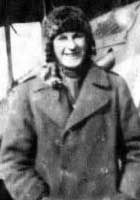Related Research Articles

Captain William James Arthur Duncan was a Canadian aviator and a professional ice hockey player, coach, and general manager. In 1926 he served as the first team captain, head coach, and general manager of the Detroit Cougars of the National Hockey League (NHL).
Group Captain Geoffrey Hilton "Beery" Bowman, was a British First World War fighter ace credited with 32 victories. After attaining the rank of major in the Royal Flying Corps, he later became a group captain in the Royal Air Force.
John Lightfoot Trollope, was a British First World War flying ace, credited with 18 aerial victories, including seven in one day, the first British pilot to do so.
Captain Frederick James Harry Thayre was a British two-seater flying ace in World War I who, in conjunction with his observer-gunners, was credited with twenty aerial victories.

Wing Commander William Mayes Fry was a World War I Royal Flying Corps and Royal Air Force fighter ace. He was credited with eleven aerial victories, piloting no fewer than four different types of fighter aircraft. Fry also has the distinction of being one of the few World War I airmen to survive to the 1990s.
John Geoffrey Sadler Candy, was a British aviator, military officer, and flying ace credited with six aerial victories during the First World War. He transferred to the Royal Air Force in 1919, and retired in 1937, but was recalled to serve throughout the Second World War, retiring permanently in 1946.
Flight Lieutenant William Geoffrey Meggitt was a British World War I flying ace credited with six aerial victories.
Richard Raymond-Barker, MC was a British aviator and flying ace, credited with six aerial victories in the First World War. He was Manfred von Richthofen's penultimate victim.
Squadron Leader Victor Rodney Stokes White (1895–1967) was an English World War I flying ace credited with six aerial victories. He returned to military service during World War II.
Lieutenant Peter Aitken MacDougall (or McDougal) (11 August 1898 – 18 August 1955) was a Scottish World War I flying ace credited with seven aerial victories.
Captain Henry Hollingdrake Maddocks was a British World War I flying ace credited with seven aerial victories.
Awdry Morris Vaucour, was a First World War flying ace credited with seven aerial victories. For part of his career he flew with observer/gunner Alan Bott, who would go on to become an ace in his own right. Vaucour was killed in Italy in a "friendly fire" incident, when he was shot down by an Italian Hanriot pilot.
Lieutenant Harold John Walkerdine was a World War I flying ace officially credited with seven aerial victories.
Flight Lieutenant Forde Leathley was an Irish First World War flying ace credited with eight aerial victories.
Flight Lieutenant Edmund Roger Tempest was a British First World War flying ace credited with 17 aerial victories.
Captain Ronald Frank Strickland Mauduit was a British cavalry officer and First World War flying ace credited with nine aerial victories.
Group Captain Gilbert Ware Murlis Green, was a Royal Air Force career officer credited with eight aerial victories. He was a pioneer among fighter aces, and his victories were scored in a variety of theatres and flying environments. He was successful on both the Western Front, in Greece, and on his home soil. He also commanded two of the original night fighter squadrons.
Captain Ian Patrick Robert Napier was a Scottish World War I flying ace credited with twelve aerial victories.
Flight Commander Guy William Price was an Irish Royal Naval Air Service flying ace during World War I, having 12 confirmed aerial victories. He was awarded the Distinguished Service Cross twice within a 22-day period.
Captain Maurice Douglas Guest Scott was a British World War I flying ace credited with twelve official victories, including one observation balloon, while a member of the Royal Flying Corps. He scored as both an aerial observer and a pilot; he was successful while serving with three different squadrons.
References
- 1 2 3 "Franklin Geoffrey Saunders". The Aerodrome. 2016.
- ↑ "Aviators' Certificates". Flight . VI (283): 39. 10 January 1914.
- ↑ "The Royal Flying Corps". Flight. VI (264): 72. 17 January 1914.
- ↑ "No. 28894". The London Gazette . 8 September 1914. pp. 7097–7098.
- ↑ "No. 30111". The London Gazette (Supplement). 1 June 1917. p. 5484.
- ↑ "No. 30597". The London Gazette (Supplement). 22 March 1918. p. 3744.
- ↑ "No. 30862". The London Gazette (Supplement). 23 August 1918. p. 9905.
- ↑ "No. 32311". The London Gazette. 3 May 1921. p. 3544.
- ↑ "No. 32368". The London Gazette. 24 June 1921. p. 5015.